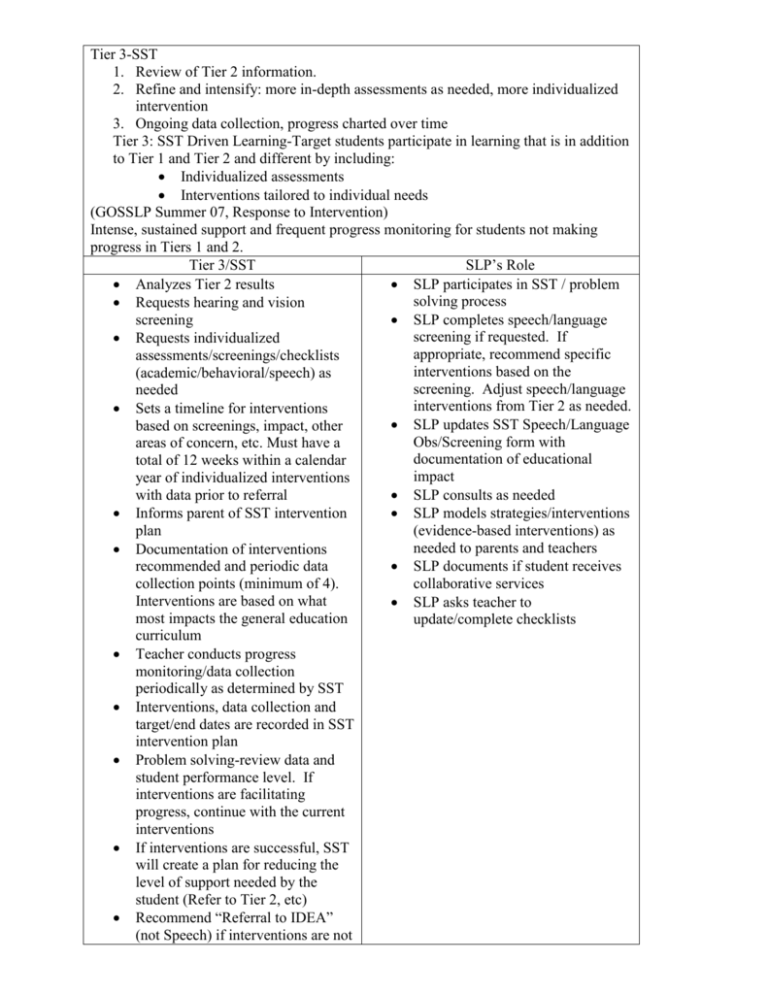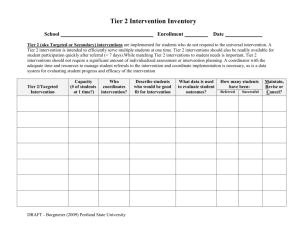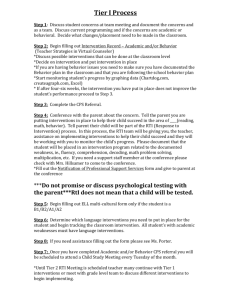Tier 3
advertisement

Tier 3-SST 1. Review of Tier 2 information. 2. Refine and intensify: more in-depth assessments as needed, more individualized intervention 3. Ongoing data collection, progress charted over time Tier 3: SST Driven Learning-Target students participate in learning that is in addition to Tier 1 and Tier 2 and different by including: Individualized assessments Interventions tailored to individual needs (GOSSLP Summer 07, Response to Intervention) Intense, sustained support and frequent progress monitoring for students not making progress in Tiers 1 and 2. Tier 3/SST SLP’s Role Analyzes Tier 2 results SLP participates in SST / problem solving process Requests hearing and vision screening SLP completes speech/language screening if requested. If Requests individualized appropriate, recommend specific assessments/screenings/checklists interventions based on the (academic/behavioral/speech) as screening. Adjust speech/language needed interventions from Tier 2 as needed. Sets a timeline for interventions SLP updates SST Speech/Language based on screenings, impact, other Obs/Screening form with areas of concern, etc. Must have a documentation of educational total of 12 weeks within a calendar impact year of individualized interventions with data prior to referral SLP consults as needed Informs parent of SST intervention SLP models strategies/interventions plan (evidence-based interventions) as needed to parents and teachers Documentation of interventions recommended and periodic data SLP documents if student receives collection points (minimum of 4). collaborative services Interventions are based on what SLP asks teacher to most impacts the general education update/complete checklists curriculum Teacher conducts progress monitoring/data collection periodically as determined by SST Interventions, data collection and target/end dates are recorded in SST intervention plan Problem solving-review data and student performance level. If interventions are facilitating progress, continue with the current interventions If interventions are successful, SST will create a plan for reducing the level of support needed by the student (Refer to Tier 2, etc) Recommend “Referral to IDEA” (not Speech) if interventions are not successful and the slow rate of learning and achievement gap is widening when compared to peers. The intensity and frequency of the interventions required for student achievement should be considered when making this determination. Prior to referral, written documentation of educational impact and data collection is required for speech/language concerns. Additionally, academic, behavioral and functional skills must be either formally or informally assessed prior to determining an IDEA referral. If concerns exist academically, behaviorally or functionally, we cannot refer for a “speech only” evaluation unless we have conclusively eliminated that any additional testing is needed in these areas. According to SI regs, an indepth evaluation of each area (speech/language, academic, behavior or functional) suspected of being impaired must be completed as part of the evaluation process.









